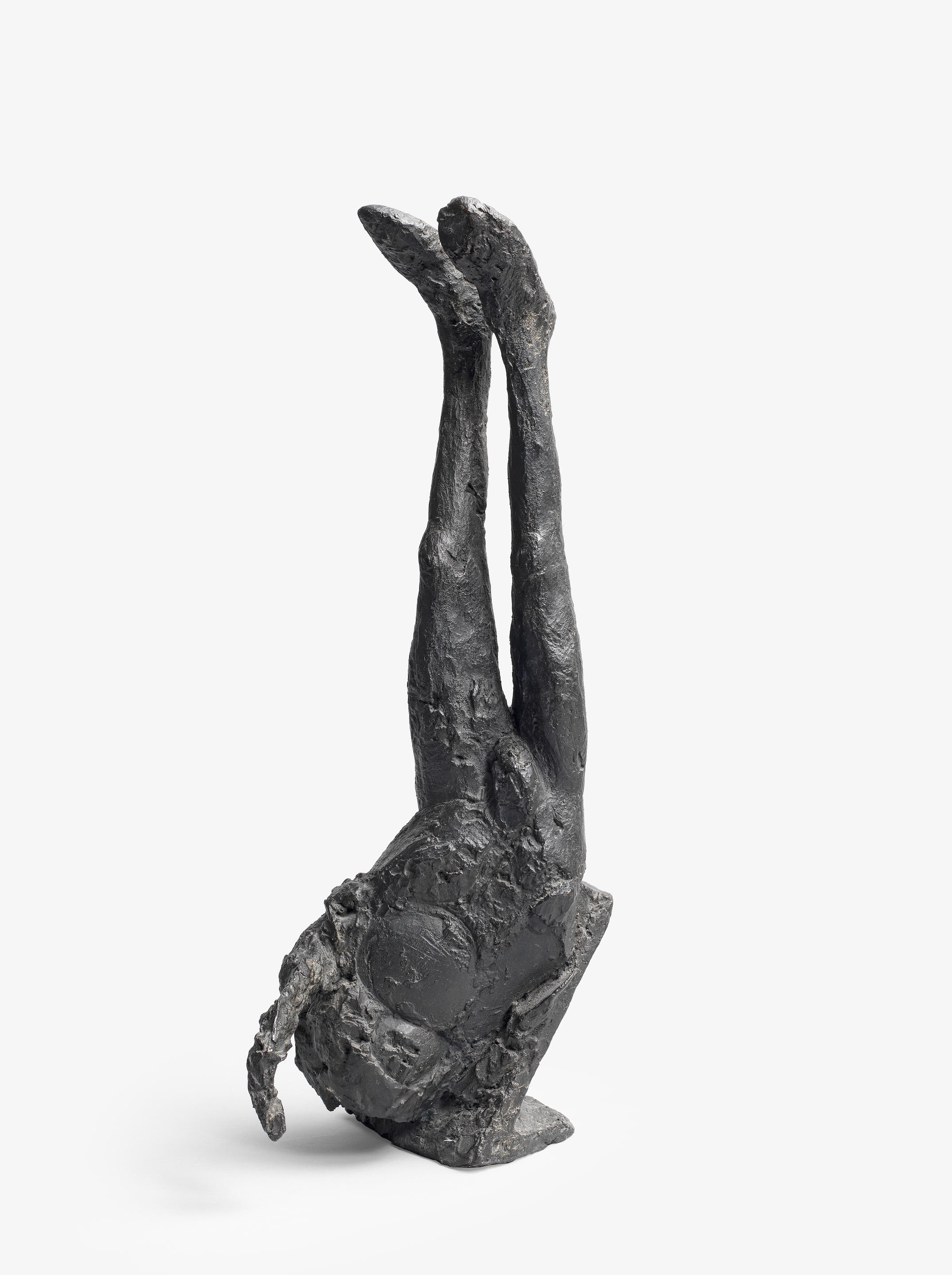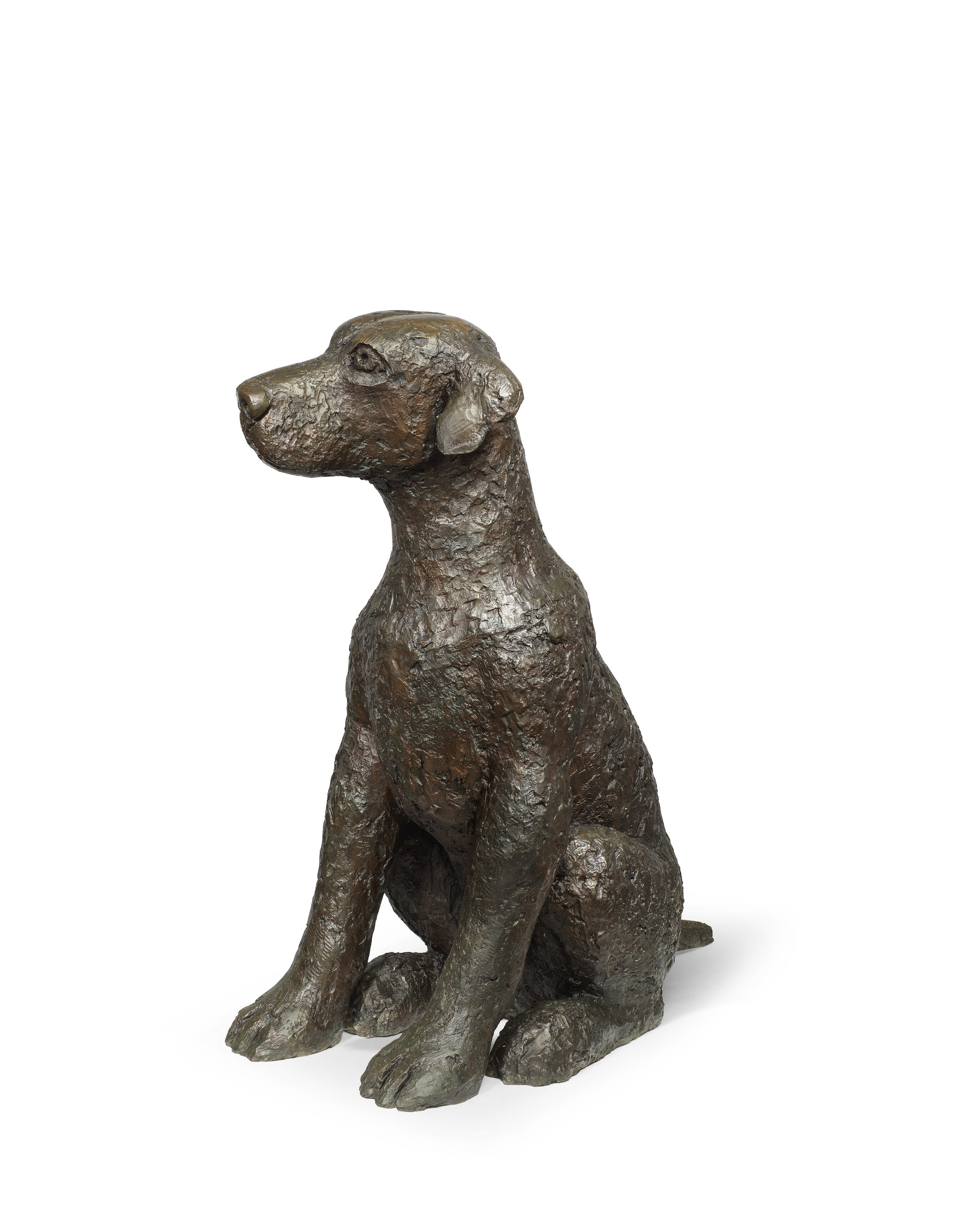Dame Elisabeth Frink R.A. (British, 1930-1993)Rolling Over Horse
signed 'Frink' (on the rear right leg)
bronze with a dark brown patina
38.9 cm. (15 1/4 in.) wide
Conceived in 1976, an Artist's Cast aside from the edition of 9FootnotesProvenance
Acquired directly from the artist by the family of the present owner
Private Collection, U.K.
Exhibited
Washington, D.C., The National Museum for Women in the Arts, Elisabeth Frink: Sculpture and Drawing 1950-1990, 1990 (another cast)
Literature
Sarah Kent and Bryan Robertson, Elisabeth Frink, Sculpture: Catalogue Raisonné, Harpvale Press, Salisbury, 1984, pp.186-7, cat.no.233 (ill.b&w, another cast)
Bryan Robertson, Elisabeth Frink: Sculpture and Drawings 1950-90, The National Museum for Women in the Arts, Washington, D.C, 1990, p.65 (another cast)
Annette Ratuszniak, Elisabeth Frink: Catalogue Raisonné of Sculpture 1947-93, Lund Humphries, Farnham, 2013, p.135, cat.no.FCR262 (ill.b&w, another cast)
Dame Elisabeth Frink's sculptures of horses are amongst her most commercial and instantly recognisable motifs with her appreciation of these powerful animals dating back to the earliest work of the 1950s. However, the highest acclaim is reserved for her equine subjects completed between 1969 and 1985, of which Rolling Over Horse (1976) is one. Speaking in reference to this celebrated period, Julian Spalding comments that 'Frink's animals came to feature more and more not as tortured harbingers of terror, but much more quietly, as themselves. Horses roll over and kick in the grass, or they lie down at ease...This is Frink at her most relaxed. She knew everything about horses and had the ability to sculpt them with both broad consequence and, at the same time, exacting precision. This accounts for their strength and agility. There's hardly any detail, but they are so alive that you expect one at any moment to flick a fly away with the swish of its tail or shake of its head' (Julian Spalding in Annette Ratuszniak (ed.), Elisabeth Frink, Catalogue Raisonné of Sculpture 1947-93, Lund Humphries, London, 2013, p.18).
Emerging in force during the late 1960s and conceived as both singular entities and with riders, they are largely the result of Frink's time spent in the Camargue region of France, renowned for its semi-wild horses and rugged landscape. Upon returning to England in 1973, shortly before the present work was conceived, the artist continued to explore and develop the horse theme within her work. As with many of the other animals she chose to sculpt and by her own admission, they are more concerned with representing her emotional response to, and spiritual identification with, the subject in question rather than with literal physical form. In view of this particularly subjective approach, Frink denied being an animal sculptor in the true sense of the notion, stating her principal interest to lie 'in the spirit of the animal'. That spirit is clearly demonstrated in the present work, whereby the horse moves with grace, free from human constraint, visible from different angles and positions in a sumptuous brown patina.
Dame Elisabeth Frink R.A. (British, 1930-1993)Rolling Over Horse
signed 'Frink' (on the rear right leg)
bronze with a dark brown patina
38.9 cm. (15 1/4 in.) wide
Conceived in 1976, an Artist's Cast aside from the edition of 9FootnotesProvenance
Acquired directly from the artist by the family of the present owner
Private Collection, U.K.
Exhibited
Washington, D.C., The National Museum for Women in the Arts, Elisabeth Frink: Sculpture and Drawing 1950-1990, 1990 (another cast)
Literature
Sarah Kent and Bryan Robertson, Elisabeth Frink, Sculpture: Catalogue Raisonné, Harpvale Press, Salisbury, 1984, pp.186-7, cat.no.233 (ill.b&w, another cast)
Bryan Robertson, Elisabeth Frink: Sculpture and Drawings 1950-90, The National Museum for Women in the Arts, Washington, D.C, 1990, p.65 (another cast)
Annette Ratuszniak, Elisabeth Frink: Catalogue Raisonné of Sculpture 1947-93, Lund Humphries, Farnham, 2013, p.135, cat.no.FCR262 (ill.b&w, another cast)
Dame Elisabeth Frink's sculptures of horses are amongst her most commercial and instantly recognisable motifs with her appreciation of these powerful animals dating back to the earliest work of the 1950s. However, the highest acclaim is reserved for her equine subjects completed between 1969 and 1985, of which Rolling Over Horse (1976) is one. Speaking in reference to this celebrated period, Julian Spalding comments that 'Frink's animals came to feature more and more not as tortured harbingers of terror, but much more quietly, as themselves. Horses roll over and kick in the grass, or they lie down at ease...This is Frink at her most relaxed. She knew everything about horses and had the ability to sculpt them with both broad consequence and, at the same time, exacting precision. This accounts for their strength and agility. There's hardly any detail, but they are so alive that you expect one at any moment to flick a fly away with the swish of its tail or shake of its head' (Julian Spalding in Annette Ratuszniak (ed.), Elisabeth Frink, Catalogue Raisonné of Sculpture 1947-93, Lund Humphries, London, 2013, p.18).
Emerging in force during the late 1960s and conceived as both singular entities and with riders, they are largely the result of Frink's time spent in the Camargue region of France, renowned for its semi-wild horses and rugged landscape. Upon returning to England in 1973, shortly before the present work was conceived, the artist continued to explore and develop the horse theme within her work. As with many of the other animals she chose to sculpt and by her own admission, they are more concerned with representing her emotional response to, and spiritual identification with, the subject in question rather than with literal physical form. In view of this particularly subjective approach, Frink denied being an animal sculptor in the true sense of the notion, stating her principal interest to lie 'in the spirit of the animal'. That spirit is clearly demonstrated in the present work, whereby the horse moves with grace, free from human constraint, visible from different angles and positions in a sumptuous brown patina.
.jpg)














Testen Sie LotSearch und seine Premium-Features 7 Tage - ohne Kosten!
Lassen Sie sich automatisch über neue Objekte in kommenden Auktionen benachrichtigen.
Suchauftrag anlegen